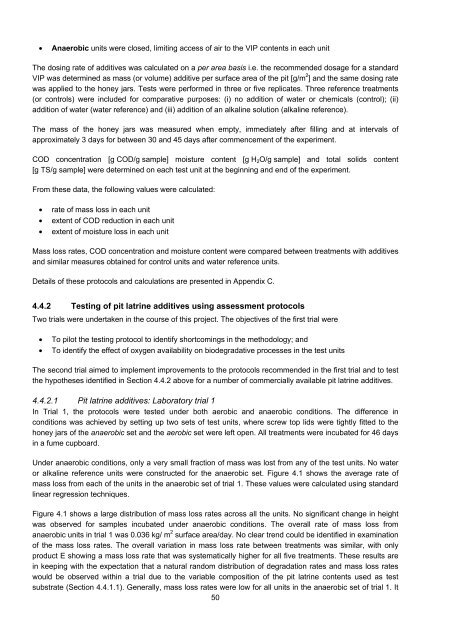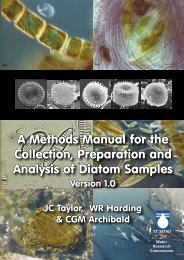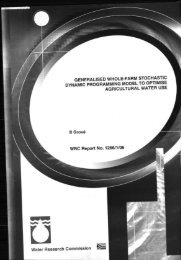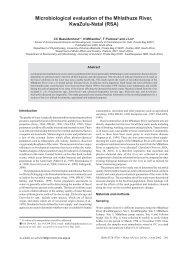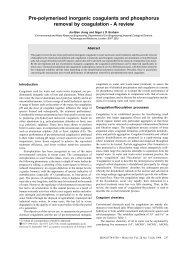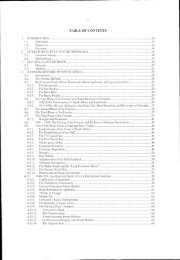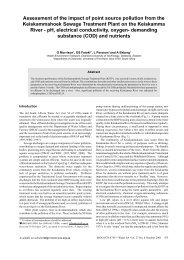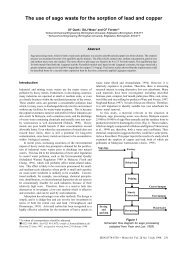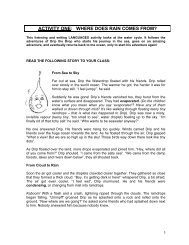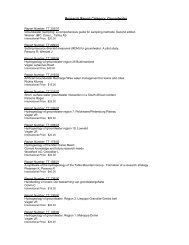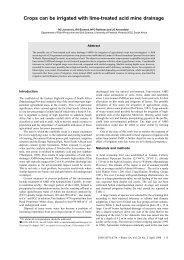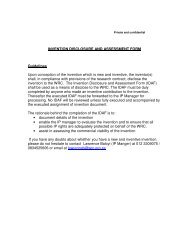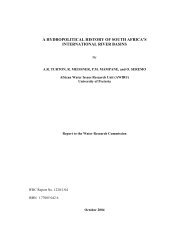and the Efficacy of Pit Latrine Additives - Water Research Commission
and the Efficacy of Pit Latrine Additives - Water Research Commission
and the Efficacy of Pit Latrine Additives - Water Research Commission
- No tags were found...
Create successful ePaper yourself
Turn your PDF publications into a flip-book with our unique Google optimized e-Paper software.
Anaerobic units were closed, limiting access <strong>of</strong> air to <strong>the</strong> VIP contents in each unit<br />
The dosing rate <strong>of</strong> additives was calculated on a per area basis i.e. <strong>the</strong> recommended dosage for a st<strong>and</strong>ard<br />
VIP was determined as mass (or volume) additive per surface area <strong>of</strong> <strong>the</strong> pit [g/m 2 ] <strong>and</strong> <strong>the</strong> same dosing rate<br />
was applied to <strong>the</strong> honey jars. Tests were performed in three or five replicates. Three reference treatments<br />
(or controls) were included for comparative purposes: (i) no addition <strong>of</strong> water or chemicals (control); (ii)<br />
addition <strong>of</strong> water (water reference) <strong>and</strong> (iii) addition <strong>of</strong> an alkaline solution (alkaline reference).<br />
The mass <strong>of</strong> <strong>the</strong> honey jars was measured when empty, immediately after filling <strong>and</strong> at intervals <strong>of</strong><br />
approximately 3 days for between 30 <strong>and</strong> 45 days after commencement <strong>of</strong> <strong>the</strong> experiment.<br />
COD concentration [g COD/g sample] moisture content [g H 2 O/g sample] <strong>and</strong> total solids content<br />
[g TS/g sample] were determined on each test unit at <strong>the</strong> beginning <strong>and</strong> end <strong>of</strong> <strong>the</strong> experiment.<br />
From <strong>the</strong>se data, <strong>the</strong> following values were calculated:<br />
<br />
<br />
<br />
rate <strong>of</strong> mass loss in each unit<br />
extent <strong>of</strong> COD reduction in each unit<br />
extent <strong>of</strong> moisture loss in each unit<br />
Mass loss rates, COD concentration <strong>and</strong> moisture content were compared between treatments with additives<br />
<strong>and</strong> similar measures obtained for control units <strong>and</strong> water reference units.<br />
Details <strong>of</strong> <strong>the</strong>se protocols <strong>and</strong> calculations are presented in Appendix C.<br />
4.4.2 Testing <strong>of</strong> pit latrine additives using assessment protocols<br />
Two trials were undertaken in <strong>the</strong> course <strong>of</strong> this project. The objectives <strong>of</strong> <strong>the</strong> first trial were<br />
<br />
<br />
To pilot <strong>the</strong> testing protocol to identify shortcomings in <strong>the</strong> methodology; <strong>and</strong><br />
To identify <strong>the</strong> effect <strong>of</strong> oxygen availability on biodegradative processes in <strong>the</strong> test units<br />
The second trial aimed to implement improvements to <strong>the</strong> protocols recommended in <strong>the</strong> first trial <strong>and</strong> to test<br />
<strong>the</strong> hypo<strong>the</strong>ses identified in Section 4.4.2 above for a number <strong>of</strong> commercially available pit latrine additives.<br />
4.4.2.1 <strong>Pit</strong> latrine additives: Laboratory trial 1<br />
In Trial 1, <strong>the</strong> protocols were tested under both aerobic <strong>and</strong> anaerobic conditions. The difference in<br />
conditions was achieved by setting up two sets <strong>of</strong> test units, where screw top lids were tightly fitted to <strong>the</strong><br />
honey jars <strong>of</strong> <strong>the</strong> anaerobic set <strong>and</strong> <strong>the</strong> aerobic set were left open. All treatments were incubated for 46 days<br />
in a fume cupboard.<br />
Under anaerobic conditions, only a very small fraction <strong>of</strong> mass was lost from any <strong>of</strong> <strong>the</strong> test units. No water<br />
or alkaline reference units were constructed for <strong>the</strong> anaerobic set. Figure 4.1 shows <strong>the</strong> average rate <strong>of</strong><br />
mass loss from each <strong>of</strong> <strong>the</strong> units in <strong>the</strong> anaerobic set <strong>of</strong> trial 1. These values were calculated using st<strong>and</strong>ard<br />
linear regression techniques.<br />
Figure 4.1 shows a large distribution <strong>of</strong> mass loss rates across all <strong>the</strong> units. No significant change in height<br />
was observed for samples incubated under anaerobic conditions. The overall rate <strong>of</strong> mass loss from<br />
anaerobic units in trial 1 was 0.036 kg/ m 2 surface area/day. No clear trend could be identified in examination<br />
<strong>of</strong> <strong>the</strong> mass loss rates. The overall variation in mass loss rate between treatments was similar, with only<br />
product E showing a mass loss rate that was systematically higher for all five treatments. These results are<br />
in keeping with <strong>the</strong> expectation that a natural r<strong>and</strong>om distribution <strong>of</strong> degradation rates <strong>and</strong> mass loss rates<br />
would be observed within a trial due to <strong>the</strong> variable composition <strong>of</strong> <strong>the</strong> pit latrine contents used as test<br />
substrate (Section 4.4.1.1). Generally, mass loss rates were low for all units in <strong>the</strong> anaerobic set <strong>of</strong> trial 1. It<br />
50


